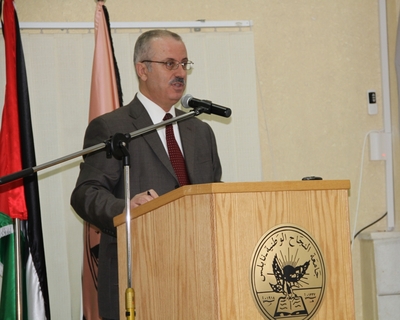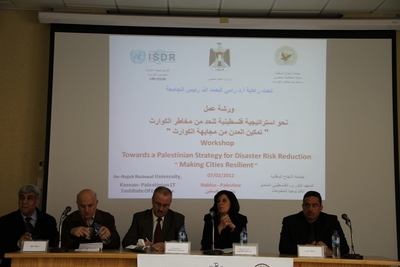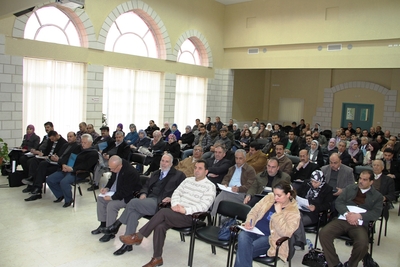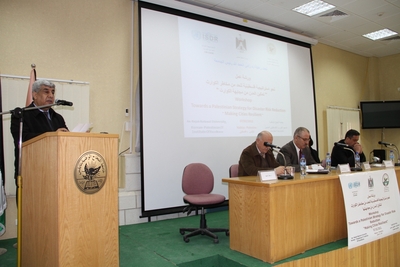Organizing a Workshop on Making Cities Resilient to Earthquakes at the University
Under the auspices of An-Najah University President, Prof. Rami Hamdallah, and in coordination with the United Nations International Strategy for Disaster Reduction (UNISDR), the Seismic Engineering Unit at the Urban Planning and Disaster Risk Reduction Center of An-Najah University and the Palestinian Ministry of Local Government organized a workshop titled “Towards a Palestinian Strategy for Disaster Risk Reduction and Making Cities Resilient”.

Attendees to the workshop included Prof. Hamdallah, President of An-Najah, Mrs. Anan Attireh, Nablus Deputy Governor, Dr. Tawfeeq Al-Budairi, Assistant Undersecretary for Engineering and Planning Affairs at the Ministry of Local Government, Engineer Adli Yaish, Mayor of Nablus, Dr. Jalal Dabbeek, Director of the Urban Planning and Disaster Risk Reduction Center and Vice President of the National Agency for Disaster Risk Mitigation in Palestine, in addition to representatives of municipalities, local government bodies, governmental and non-governmental institutions working in the field of disaster risk reduction, civil defense, the Engineering Association, the Red Crescent, the National Agency for Disaster Risk Mitigation, the Contractors Union, as well as representatives of several international organizations.
In the opening session Prof. Hamdallah delivered a speech in which he welcomed the guests saying that over the last few years people have become busy with news of earthquakes that hit different countries and concerns have aroused among them. Lately, the Seismic Engineering Unit at An-Najah has worked on raising the public awareness regarding earthquakes and their risks through distributing brochures and enforcing laws to reduce the hazards that earthquakes bring about.

Moreover, he said that the University’s scientific centers are continuously conducting various studies and research work on earthquakes and other natural disasters according to a comprehensive and integrated strategy. Meetings and workshops are also organized on this subject to discuss the current achievements and possible future developments.
He also explained that the University is cooperating with the various Palestinian institutions in different projects such as water projects, environment, urban planning, building and transportation, protection of the cultural and architectural heritage, the assessment of disasters risks….etc.
Prof. Hamdallah mentioned that the Seismic Engineering and the Urban and Regional Planning Units work on the local and regional levels in providing the foundations and standards required for strategic planning that aims at building the capacity of institutions to deal with disasters. Through 15 years oc continuous work the targeted institutions and organizations locally, regionally and internationally have been recognized. He also said that the Center has provided many Arab and foreign institutions valuable consultation and assistance with respect to dealing with disastrous situations.

Mrs. Attireh called upon decision makers to adopt the recommendations of the workshops, seminars and meetings that are held to address the issue of disasters. She also called for more coordination with the experts in order to set a work plan for the reduction of disasters risks.
Dr. Al-Budairi said that the increase in population is among the reasons that could contribute to the severity of the situation in case a certain disaster takes place. He explained that the percentage of population in Gaza is 2400 persons per square km, while in the West Bank the percentage is 600 persons per square km.
He added that the Ministry of Local Government has achieved many strategies in the field of disaster risk reduction and pointed out that the workshop aims to protect the Palestinian individual according to scientific basis; he called for an integrated coordination plan for all of the sectors in the country to make cities resilient to disasters.
Dr. Dabbeek spoke about the establishment of UNISDR back in 1999 and said that the UN has contributed to the building of the Hyogo Framework for Action to build the nations’ and communities’ capacity. He also spoke about the objectives of the UNISDR which include the integration of disaster risk reduction into sustainable development, and the reinforcement of institutions’ capacity to deal with disasters.
The workshop consisted of a number of lectures in the first of which Dr. Dabbeek spoke about the comprehensive approaches, the disaster risk reduction strategies according to the Hyogo Framework for Action 2005-2015, and the Arab Strategy for Disaster Risk Reduction 2011-2020. In his other lecture, Dr. Dabbeek spoke about the main elements of planning for preparedness, the ten-point checklist for making cities resilient, in addition to information, nomination and participation of cities in the World Campaign “Making Cities Resilient”.

In another lecture, Dr. Al-Budairi spoke about the laws and regulations regarding disaster risk reduction in Palestine.
Engineer Ammar Salameh, Director of Disaster Management at the Civil Defense, spoke about the potentials and accomplishments of the civil defense on the national level regarding raising the public awareness about disasters. He also spoke about the national report related to the Hyogo Framework for Action and its compatibility with the strategic objectives of this Framework. Moreover, he spoke about the training courses that the Civil Defense holds which target more than 10,000 individuals and train them on dealing with disasters.
Based on the lectures and discussions, the participants proposed a number of recommendations for the reduction of disasters risks in Palestine including:
- Consider disasters a national priority which requires preparing comprehensive national plans and clear execution mechanisms of these plans.
- Design mechanisms for following up on the municipalities’ and local government bodies’ commitment to the requirements of safe cities, ensure their participation in the World Campaign, and coordinate joint work between the related bodies to implement the Ten-point Checklist for making cities resilient.
- The necessity to activate the role of the Supreme Council of Civil Defense and work according to the principles and concepts of the related international institutions.
- The necessity to activate cooperation between the Supreme Council of Civil Defense and research centers especially when taking decisions concerning disaster risk reduction.
- The necessity that Palestinian institutions adopt the concepts of the International and Arab Strategies for disaster risk reduction.
- Implementing the recommendations and decisions related to the application of the Seismic Building Code in Palestine as soon as possible, as well as setting the necessary mechanisms related to the design and execution of buildings, and emphasizing the importance of developing special programs for the development of the planers and engineers’ potentials who work in the field of buildings’ design and implementation.
- Adopting policies for the use of land in its comprehensive and to work on producing hazard maps on the national level in addition to detailed maps for every city; this can be implemented gradually and in stages.
- Develop the level of coordination between partners and emphasize the importance of civil society institutions and their role in disaster risk reduction.
- Work on accomplishing stand-by plans for each institution in order to enable them to deal with emergency situations.
- Abide by the principles of prevention and public safety at the different official and non-official institutions, and to work on achieving the safe city concept.
- Train and prepare the staff working at the different municipalities, the governorate and the related institutions on prevention, public safety and risk reduction issues.
- Give priority to support the civil defense by providing it with the necessary equipment and staff for it to carry out its duty in the best way possible.
- Taking into consideration the cultural diversity and the existence of different age groups and vulnerable people when planning for disaster reduction.
- Include the social kind in decision-making concerning disaster reduction.
- Raising societal awareness towards disasters risk reduction through school and university curricula, in addition to the utilization of the different means of media.
The challenges:
In order to fulfill the abovementioned recommendations effectively the following challenges must be taken into consideration that the Palestinian institutions face.
- High probability of natural disaster occurrence, including earthquakes and man-made disasters.
- Lack of knowledge and experience in Contingency Planning (CP) and Disaster Management.
- High seismic vulnerability of many buildings and infrastructures in Palestine.
- Lack of the national planning policy to integrate the DRR with sustainable development.
- Centralization and the existence of resistance to the concept of de-centralization at some levels.
- Difficulty in adopting the concept of integration, partnership and networking between the related Palestinian institutions.
- High level of the risks (High probability and High magnitude) and limited a time frame and limited resources for implementing the DRR requirements presented in the findings and recommendations.
- Movement restrictions due to the occupation.
- Uncertainty of financial resources over the next few years and an inadequate distribution of infrastructures and human resources.



